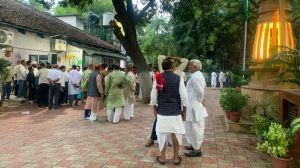Malgudi,Then and Now
Rasipuram krishnaswami Iyer Narayanaswami,BA,had just emerged from an unfortunate stint of schoolmastering.
2011 marks the 10th death anniversary of one of Indias most-loved authors,RK Narayan. Step back with us to Malgudi,that vague place not found anywhere,peopled with sign-painters and sweet vendors,Swami and his friends. Was it really a timeless stage for the charming human comedy of small men and small schemes? And what would it have been today,this small town in 21st century India?
Rasipuram krishnaswami Iyer Narayanaswami,BA,had just emerged from an unfortunate stint of schoolmastering. An abject failure in the classroom,he had returned to his family home in Mysore,trying hard to give the impression of knowing what he was doing. He would wake,bathe,and take his coffee his standards were exacting and head out,an umbrella in one hand,a pen and pad in the other. Under a tree at the foot of Chamundi Hill,he would sit and write.
Inevitably,a sceptical uncle demanded to inspect the fruits of the young mans endeavours. He was unimpressed: Whats this Malgudi? Where is it? Why do you write about some vague place not found anywhere,while there are millions of real places you can write about?
Narayanaswami managed to disregard the uncles advice to forget all that damnfool stuff about Malgudi and such things,but the first publishers to read the novels manuscript were not encouraging. No plot,they complained. Several rejection slips later,the manuscript reached Kittu Purna,a neighbour of Narayanaswamis then at Oxford,instructing him to drown the wretched thing in the Thames. Enthusiastic about the novel he had followed it avidly through multiple drafts Purna did not comply.
A cable made its way to Mysore: Novel taken,it said. Stop. Graham Greene responsible. A letter from Greene followed:
My friend Kit Purna sent me your novel the other day to read,and I should like to tell you as a fellow novelist how much I admired it. I took the liberty of sending it with a covering letter to a publisher and I have heard from him today that he wishes to publish it.
Swami and Friends was published soon after,in October 1935. The name on the cover,shortened on Greenes advice,was RK Narayan.
The rest,we might say,is history,except that the history in question is,for the most part,yet to be written. Narayans own memoirs My Days (1974) charming as they are,tell only the smallest part of a rich story,and the promising RK Narayan: The Early Years (1996) by N Ram and Susan Ram stops in 1945,is out of print,and the promised second volume covering the years 1946 to 2001 has failed to come. Ten years after the novelists death,the time is ripe for a full-length biography.
Perhaps this hypothetical biographer will be able to give a better answer to Narayans uncles questions than Narayan managed to do himself. To the question Where is Malgudi? the obvious answer was that it is a small town in south India,with something in it of Mysore,Coimbatore,Chennapatna,and the streets of Madras in which Narayan spent his earliest childhood.
Of course,Narayans own stock reply to the question was that To say that [Malgudi is a small town in south India would only be a half-truth. You can detect its characters in any part of the world,in far-flung places like New York or Chicago or Warsaw,even Paris. Indeed,it is a mistake to assume too readily as people often do that Mysore,in which Narayan spent his most productive years,was the model for Malgudi. For one thing,Malgudi is usually depicted as a conspicuously Tamil-majority town with none of Mysores associations with royalty and high culture.
It is,however,the uncles third question that is the most intriguing: why did Narayan set his fiction in some vague place not found anywhere? The answer,in his own telling,does not appear to have been a matter of choice.
An unemployed recent graduate,Narayan was in Bangalore,staying with a convalescing grandmother,spending his days,as he put it,dreaming and thinking and planning. Then it happened:
On a certain day in September,selected by my grandmother for its auspiciousness,I bought an exercise book and wrote the first line of a novel; as I sat in a room nibbling my pen and wondering what to write,Malgudi with its little railway station swam into view,all ready-made.
Narayan passes lightly over this moment,as if there were no more to be said. But it is a quite remarkable moment in the history of Indian literature. VS Naipaul,a writer whose early comic novels show obvious affinities with Narayans,describes the moment around 20 years later when he transcribed the first sentence of Miguel Street from a childhood memory,and found the subsequent sentences pouring forth. It is an exact parallel of Narayans vision of a character called Swaminathan running down the [railway platform,setting a rhythm for him,as day by day pages grew out of it linked to each other.
Narayan would write other well-regarded novels after Swami and Friends The Guide being the most famous but his first novel remains his greatest achievement. As the novelist Pankaj Mishra,an admirer of Narayan,has put it,there are moments when a writer enters into an honest relationship with his experience,when he finds his characters and settings already prepared for him,when he doesnt have to find his subjects,they find him. Malgudi,then,was not an invention of Narayans. It was,in some mysterious sense,already there,waiting to be discovered.
Malgudi was a 24-hour journey away from Madras,but not much further from Warsaw,or New York,or Trinidad. Its
appeal,as Narayan was himself fond of pointing out,was potentially universal. And Malgudis universality came precisely from,not despite,its being a very particular place,at a very particular time.
Narayan was not one to speak of these matters explicitly,but Malgudi was a town whose people were divided as they would be in all the usual ways: caste,class,gender,and religion. Equally,they were brought together in all the usual ways: blood,friendship,enmity,and work. The Malgudi of the novels is not,contrary to an old cliché,in any sense timeless. It is shaped by all the usual forces of history,religion,conquest,migration,and colonialism,though Narayan never alluded to these matters explicitly.
Some have been troubled by Narayans silence on the big questions.
VS Naipaul,for example,devotes several chapters of his 1977 travelogue India: A Wounded Civilization to a discussion of his complicated relationship with Narayans novels.
In fact,Narayan and Naipaul had met once,in London in 1961. Asked about the prospects for India after Nehru,Narayan had pronounced sagely: India will go on. Naipaul thought a great deal about this on his trips to India,and found that he could not accept such a view of things. For all the charm and human comedy of Narayans fictional universe of small men,small schemes,big talk,limited means,Naipaul was struck by the fact that disturbance,instability,development lay elsewhere. To enter into Narayans ironic acceptance and relish his comedy,was to ignore too much of what could be seen the violence,the dirt,the misery.
Mutiny and non-conformism of a sort do appear in Narayans novels,in the form of militant nationalists in Waiting for the Mahatma (1955),an irreverent taxidermist in The Man-eater of Malgudi (1961),and as a crusading birth control activist in The Painter of Signs (1977). But the irony,the scepticism about all human enthusiasms never left Narayan. This is a trait he shared with Naipaul. However,Narayan was just as ironic,just as sceptical,about something else: the pursuit of happiness. It was this attitude,which Naipaul labelled Hindu,that many find difficult to stomach.
Naipaul reserved his sharpest words for Narayans The Vendor of Sweets (1967) which tells the tragicomic story of Jagan,a former small-time satyagrahi forced to confront the modern world in the form of his foreign-returned sons rebellion. In Naipauls mind,the sons rebellion was one example of how fragile Narayans world was,and how it could not accommodate the simplest idea of human possibility. In other words,Narayans Malgudi had no place for the million mutinies of India since the 1980s.
If we could visit Malgudi,we would see changes of the same sort we see elsewhere in small-town India. Cable television,the internet,mobile phones,certainly,and more generally,a rise in wealth and entrepreneurship. No doubt the great social movements based on caste and religion of the last few decades,many of them violent,would have left their mark on the small town. Some of this has been chronicled by other Indian writers Pankaj Mishra in Butter Chicken in Ludhiana (1995),or Naipaul in his own India: A Million Mutinies Now (1990). Perhaps the novel Narayan was planning from his hospital bed would have dealt with some of these matters.
Yet,the mutinies of contemporary India invite us to pose some of Narayans questions. Does money necessarily make one happier? And to what extent are happiness and suffering,success and failure,matters not of individual striving but of luck?
These are deep questions,but we should not be too quick to write off Narayans response,not so much an answer as an attitude: of irony,of scepticism,of caution,and a faith that Malgudi,and India,will go on. n
(The writer is doing a doctorate in philosophy at the
University of Oxford)
Photos






- 01
- 02
- 03
- 04
- 05

























